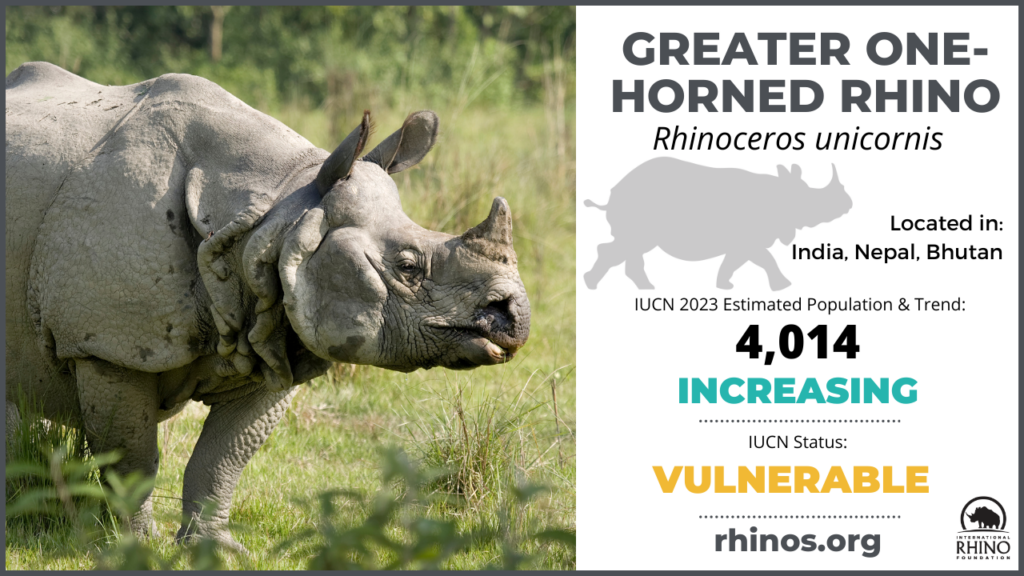Physical Address
23,24,25 & 26, 2nd Floor, Software Technology Park India, Opp: Garware Stadium,MIDC, Chikalthana, Aurangabad, Maharashtra – 431001 India
Physical Address
23,24,25 & 26, 2nd Floor, Software Technology Park India, Opp: Garware Stadium,MIDC, Chikalthana, Aurangabad, Maharashtra – 431001 India

A recent report states that poaching and habitat loss are the two most significant factors causing rhinoceros populations to dwindle, but climate change is increasingly impacting many facets of rhino survival.
The International Rhino Foundation released a report just two days before the global celebration of World Rhino Day on September 22. The report provides an update on the status of the world’s five rhino species, and the news is a mixed bag.
Among the five species, scattered across the world, black rhinos and greater one-horned rhinos are showing ongoing population increases. However, two other species, white rhinos and Sumatran rhinos, have been facing declines (although there was a recent report of an increase in white rhino numbers over the past two years, which is encouraging but not yet established as a long-term trend). The status of the remaining species, the Javan rhino, remains uncertain in terms of its population trend.
How Climate Change is Affecting Rhinos
According to the report, in India and the broader Asian region, the prospect of significantly increased rainfall and prolonged monsoon seasons presents a heightened risk of direct harm to rhinos. These extended periods of heavy rainfall can already strand some greater one-horned rhinos on temporary islands or lead to drownings, as well as the separation of calves from their mothers. These adverse effects would only worsen with more intense storms. Moreover, the regular occurrence of flooding conditions could elevate the risk of diseases affecting rhinos. Changes in weather patterns and landscapes might also promote the proliferation of invasive plant species, which can outcompete native rhino food sources and lead to overall habitat deterioration.
The threats posed by climate change are diverse and vary depending on the species in question. In contrast to the effects of increased precipitation in Asia, on the other side of the spectrum, in Africa, climate change-induced drought is inflicting numerous harmful consequences on human communities. These consequences, in turn, can trigger a domino effect on wildlife. Competition for water resources may intensify, exacerbating conflicts and disruptions between communities as well as between humans and wildlife. This proximity between people and rhinos may heighten the risk of encounters. The poverty resulting from crop and livestock losses due to drought may also drive an upswing in poaching as a means of income generation. Additionally, arid conditions could lead to an increase in wildfires, resulting in habitat loss for rhinos.
Poaching- the biggest threat
The primary threat to all five rhino species is the illegal trade in rhino horns. Globally, rhino populations that were once considered less vulnerable have now become the primary focus of poaching activities, orchestrated by highly organized, cross-border criminal networks. In 2023, India, which had recorded no poaching incidents the previous year, experienced two poaching cases—one in Kaziranga National Park and another in Manas National Park. Additionally, Indonesia’s Ujung Kulon National Park, the exclusive habitat of Javan rhinos, has witnessed a disturbing rise in intrusion attempts over the past year. Indonesia’s Ministry of Environment and Forestry has reported an unnatural death of a Javan rhino, which is currently under investigation.

In Africa, there is a shift in poaching patterns. In the past year, poachers have redirected their attention from larger rhino populations to smaller ones, which may be more vulnerable. As poaching pressure intensifies across the continent, the number of white rhinos, the most numerous among the five species, continues to decrease. This dispersal of rhinos across larger national parks and reserves can make it more challenging for poachers to locate them. Consequently, large protected areas like Kruger National Park in South Africa have significantly increased security measures to reduce poaching incidents within their boundaries. Poachers, in response, have targeted smaller areas like the province-run Hluhluwe Imfolozi Game Reserve, which has seen a high number of rhino poaching incidents in South Africa over the past year. Namibia, home to the world’s largest black rhino population, experienced a devastating 93% increase in rhino poaching from 2021 to 2022.
Positives in the report
Despite the threats, greater one-horned rhinos continue to prosper thanks to robust protection measures and strict enforcement. While official censuses were not conducted by the governments of India and Nepal this year, authorities have a belief that the rhino population is on an upward trajectory.
India, Bhutan, and Nepal collaborate closely to implement a cross-border management strategy for the greater one-horned rhino. This joint effort, coupled with stringent government protection and management, has led to a consistent increase in the greater one-horned rhino population over the past century, with a notable growth of approximately 20 percent in the last decade.
Meanwhile, black rhinos in Africa represent a cautiously optimistic success story, showing a significant resurgence in recent decades despite ongoing challenges from poaching. These two positive trends underscore the potential of human determination and capability when governments are committed, conservationists are devoted, and communities actively support these efforts. Given the right interventions, there is hope that all five rhino species can rebound and thrive in our ever-changing world.
The Greater One-Horned Rhino (GOHR)
The Greater One-Horned Rhino, also known as the Indian Rhino, holds the title of being the largest among all rhino species. In the past, these rhinos used to roam freely across the northern regions of the Indian subcontinent, but their numbers sharply declined due to hunting for sport and their role as agricultural pests. This drastic decline brought them to the brink of extinction, with only about 200 wild Greater One-Horned Rhinos left by the early 20th century.

These rhinos thrive in grassland habitats, but changes in these environments present a significant and unavoidable threat. The deterioration in the quality of grasslands primarily results from the spread of invasive species and natural changes in vegetation, exacerbated by shifts in water patterns. All these factors collectively endanger the habitats crucial for the rhinos’ survival.
Despite facing these immense challenges, these rhinoceroses have shown incredible resilience and serve as a living testament to the ongoing struggle for their conservation and protection.
The Indian Rhino is a unique case in Asia, being the only large mammal species to have been reclassified from “endangered” to “vulnerable” on the IUCN Red List in 2008. At the outset of the 20th century, its population had dwindled to just a few hundred individuals. However, despite this reclassification, the species still faces substantial risks due to its limited geographic range. The majority of these rhinos, approximately 67% of the global population, amounting to 3,622 individuals, are concentrated within Kaziranga National Park in Assam, India. This concentration makes them highly vulnerable to unforeseen events and natural disasters.
“The recovery of the Greater One-Horned Rhino is among the greatest conservation success stories in Asia. Thanks to strict protection and management from Indian and Nepalese wildlife authorities, the greater one-horned rhino was brought back from the brink. Today, populations have increased to around 4,000 rhinos in northeastern India and the Terai grasslands of Nepal,” said the World Wildlife Fund.
Why should we save the Rhino?
Rhinos play a crucial role in the savannah ecosystem. These massive herbivores spend hours grazing on grasslands, which helps maintain the vegetation’s structure, encourages fresh growth, and consequently provides additional food and grazing spaces for various other herbivores. Through their selective feeding habits, rhinos enhance plant biodiversity, enabling certain plant species to flourish in the savannah. This, in turn, transforms the savannah into a natural carbon sink, effectively absorbing harmful carbon dioxide from the atmosphere.
Beyond the ecological and environmental advantages, many local communities residing alongside rhino habitats also reap benefits. Tourism constitutes a significant source of employment and income for people living near Rhino Habitats. Animals like rhinos serve as major attractions for wildlife enthusiasts, photographers, and safari enthusiasts from around the world, all eager to catch a glimpse of the gentle and majestic creature.
The way ahead
A 2020 study proposes several strategies to safeguard rhinoceros populations in light of climate change. One key recommendation involves the planning and management of wallowing sites for rhinoceros, as these sites are crucial components of their habitat. Wallowing in mud pools serves as an important thermoregulation mechanism for rhinoceros, which could prove to be an effective adaptation strategy in the face of anticipated climate change impacts.
Additionally, the report suggests the development of a comprehensive flood model to pinpoint areas within rhinoceros habitat susceptible to various flood levels. This information can then inform the creation of climate refugia, designated safe zones to protect rhinoceros during future flood events. Similarly, the study advises the identification and establishment of suitable corridors for rhinoceros and the removal of human-made barriers that hinder their movement to higher and safer terrain when floods occur.
Furthermore, the study advocates for the construction and maintenance of a mosaic of grasslands and wetlands by eliminating invasive plant species, which would enhance the overall habitat quality for rhinoceros.
If you have any queries or come across suspicious content related to climate change or the environment and want us to verify them, send them to Climate Buddy, our WhatsApp tipline +91 70453 66366.
References:
https://rhinos.org/wp-content/uploads/2023/09/State-of-the-Rhino-2023_Final_Updated-9212023-.pdf
https://www.sciencedirect.com/science/article/pii/S2351989420307216
Image: https://www.savetherhino.org/rhino-info/rhino-species/greater-one-horned-rhino/